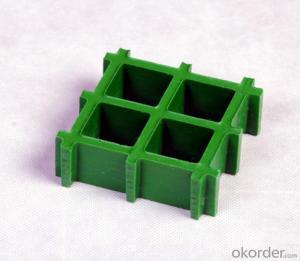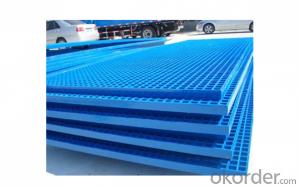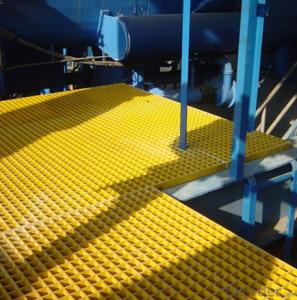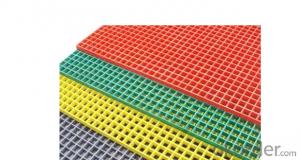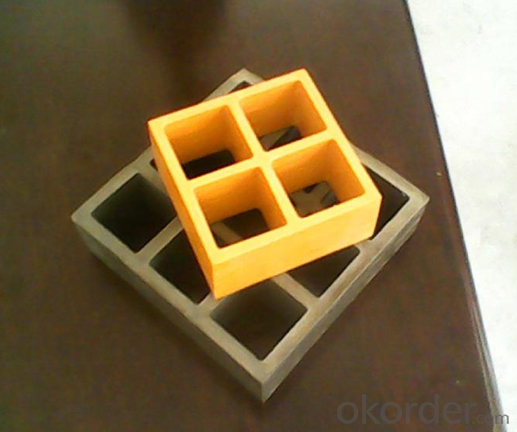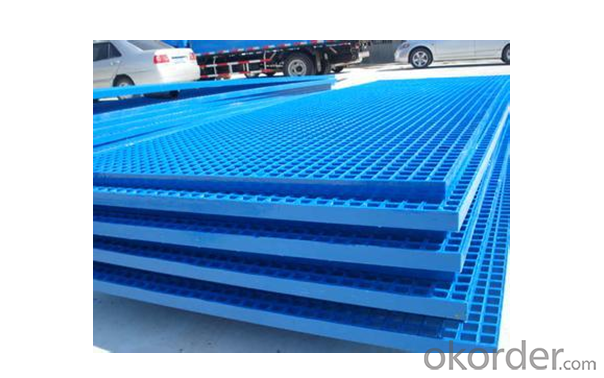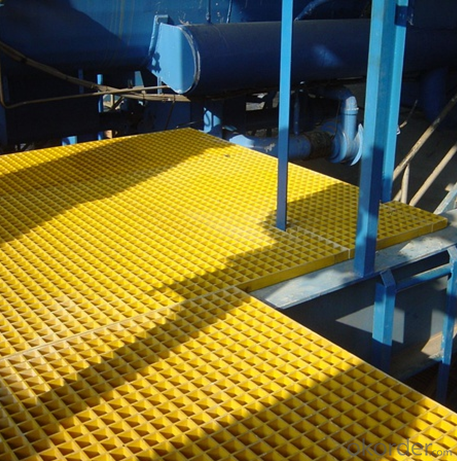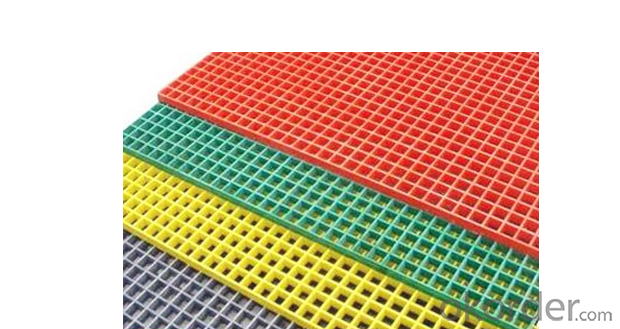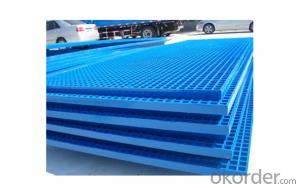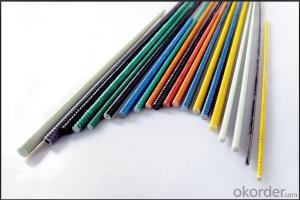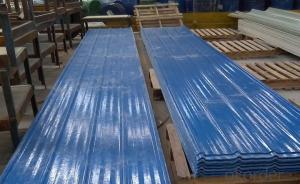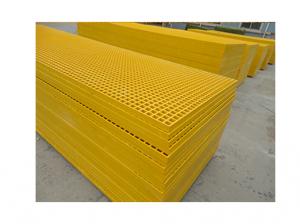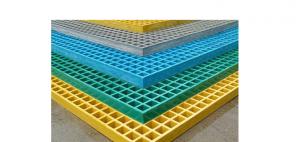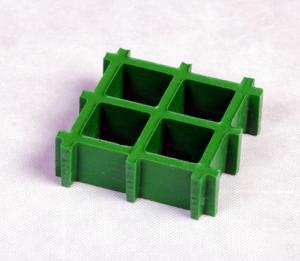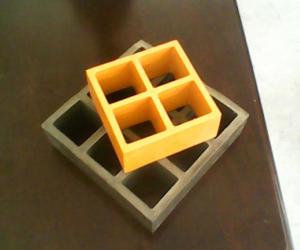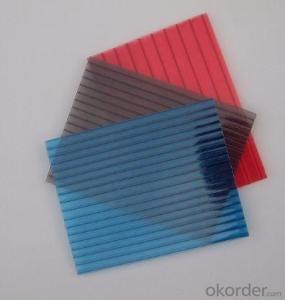FRP Pultrusion Profiles - Corrosion Resistant and Fire Resistant FRP Gratings in All Kinds of Colors
- Loading Port:
- China main port
- Payment Terms:
- TT OR LC
- Min Order Qty:
- 100 m²
- Supply Capability:
- 500000 m²/month
OKorder Service Pledge
OKorder Financial Service
You Might Also Like
Introduction
FRP Molded Grating is a structural panel which uses high-strength E-Glass roving as reinforcing material, thermosetting resin as matrix and then casted and formed in a special metal mold. It provides properties of light weight, high strength, corrosion resistance, fire resistance and anti-skid. FRP Molded Grating is widely used in oil industry, power engineering, water & waste water treatment, ocean survey as working floor, stair tread, trench cover, etc. and is an ideal loading frame for corrosion circumstances.
Feature
l Light Weight & High Strength
l Safety & Anti-slip
l Electrical Insulating
l Aging Resistance
Specification
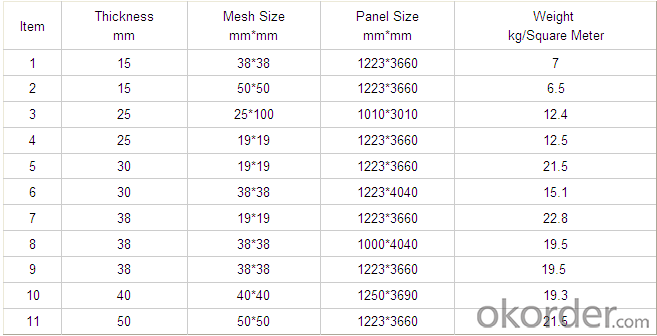
Advantage
1) no maintenance
2) high strength
3) long service life
4) easy installation
Application
l In high voltage electrical equipment for power line work, in order to prevent workers go wrong location, charged interval or near electrically charged equipment to dangerous distance.
l Pool railings in sewage treatment industry
l Corrosive chemical industry equipment around the fence
l All kinds of building maintenance section
FAQ
1. How about the documents after shipment?
After shipment, we ll send all original documents to you by DHL, including Packing List.Commercial Invoice, B/L, and other certificates as required by clients.
2. How long is the delivery time?
Usually it takes 10-25days after receipt of the deposits or L/C, and it also depends on the quantity of your order.
3. How is the package?
Usually, we arrange .the standard out-package for exporting.
PROCESS
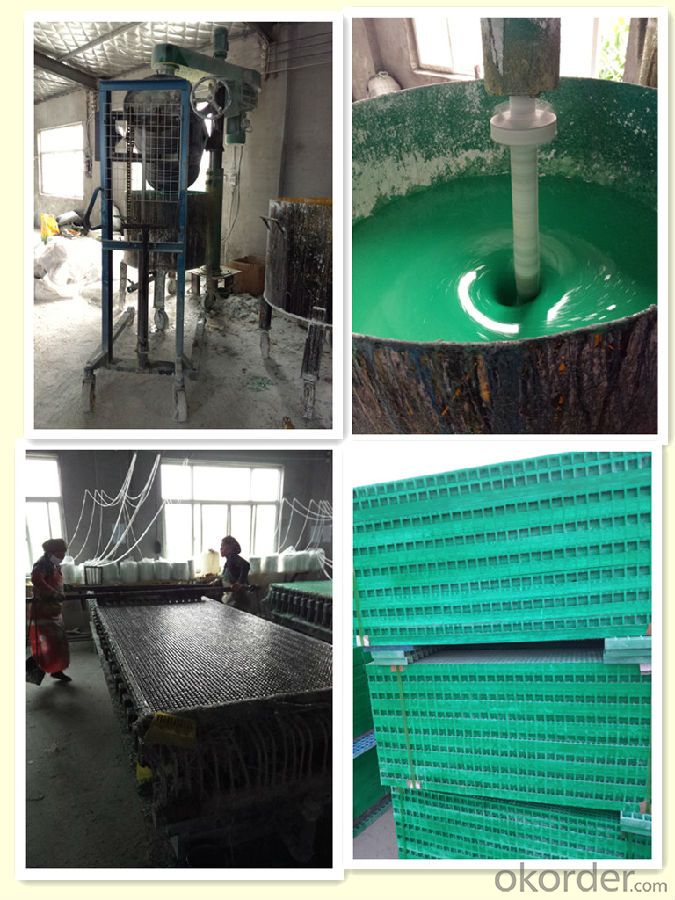
FACTORY
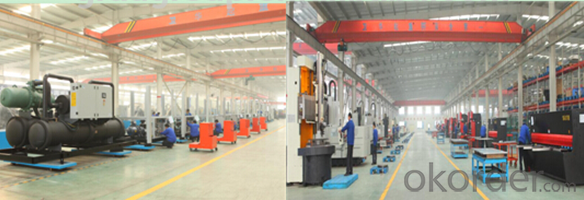
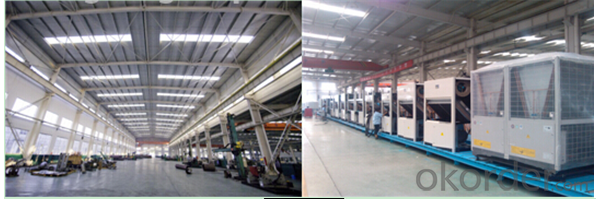
- Q: Are FRP pultrusion profiles resistant to jet fuel?
- Yes, FRP pultrusion profiles are generally resistant to jet fuel.
- Q: Can FRP pultrusion profiles be used in the construction of railway sleepers?
- The use of FRP (Fiber Reinforced Polymer) pultrusion profiles is indeed possible in the construction of railway sleepers. These profiles possess a range of advantages that render them suitable for this particular application. To begin with, the lightweight yet robust nature of FRP pultrusion profiles makes them an ideal option for railway sleepers. They boast high strength-to-weight ratios, enabling them to withstand heavy loads and reliably support the weight of trains. Moreover, their lightweight constitution facilitates transportation and installation, thereby reducing construction time and costs. Additionally, FRP pultrusion profiles exhibit a high resistance to corrosion, a crucial aspect for railway sleepers. Unlike traditional materials such as wood or steel that are prone to corrosion when exposed to moisture and chemicals, FRP profiles are non-corrosive. Consequently, they do not necessitate regular maintenance or replacement due to rust or decay. Furthermore, these profiles offer exceptional durability and longevity. They can withstand UV radiation, extreme temperatures, and chemicals, ensuring a longer lifespan compared to conventional materials. As a result, the need for frequent replacements is minimized, leading to reduced maintenance and lifecycle costs. Moreover, FRP pultrusion profiles can be tailored to meet specific design requirements. They can be manufactured in various shapes and sizes to accommodate different railway sleeper designs, providing flexibility in construction. Additionally, they can be produced in different colors, allowing for aesthetic customization. Lastly, FRP pultrusion profiles possess excellent electrical insulation properties, a critical factor for railway sleepers. They are capable of providing insulation between the train tracks and the ground, preventing electrical interference and ensuring safe operation. In conclusion, FRP pultrusion profiles are a suitable choice for constructing railway sleepers due to their lightweight yet strong composition, corrosion resistance, durability, customization options, and electrical insulation properties.
- Q: Are FRP pultrusion profiles resistant to ultraviolet radiation?
- Yes, FRP (Fiber Reinforced Polymer) pultrusion profiles are typically resistant to ultraviolet (UV) radiation. The nature of the materials used in FRP profiles, such as fiberglass and resins, provides inherent UV resistance. These profiles are manufactured using a pultrusion process that involves impregnating reinforcing fibers with a UV-resistant resin matrix and then curing them. This combination of materials and manufacturing technique ensures that FRP pultrusion profiles can withstand prolonged exposure to UV radiation without significant degradation or loss of mechanical properties. As a result, FRP pultrusion profiles are commonly used in outdoor applications where UV resistance is essential, such as construction, infrastructure, and marine industries. However, it is important to note that the level of UV resistance can vary based on the specific composition of the FRP profile and the quality of the manufacturing process. Therefore, it is always recommended to consult the manufacturer's specifications and guidelines for the specific product being used to ensure its suitability for UV-exposed environments.
- Q: Can FRP pultrusion profiles be used in the construction of recreational vehicles (RVs)?
- Yes, FRP pultrusion profiles can be used in the construction of recreational vehicles (RVs). These profiles offer several advantages such as high strength-to-weight ratio, resistance to corrosion and rot, and excellent thermal insulation properties. Additionally, FRP pultrusion profiles can be easily molded into complex shapes, making them suitable for various applications within the construction of RVs, including structural components, flooring, walls, and roofs.
- Q: What is the dimensional stability of FRP pultrusion profiles?
- The dimensional stability of FRP (Fiber Reinforced Polymer) pultrusion profiles is generally very high. This is due to the unique structural characteristics of FRP materials and the pultrusion manufacturing process. FRP pultrusion profiles are made by pulling continuous fibers, such as glass or carbon, through a resin bath and then through a heated die. The resin is typically a thermosetting polymer, which means it undergoes a chemical reaction during the curing process to become a rigid and durable material. The pultrusion process ensures that the fibers are evenly distributed and aligned within the profile, resulting in a highly uniform and consistent material. This uniformity contributes to the dimensional stability of FRP pultrusion profiles. Furthermore, the thermosetting nature of the resin matrix provides excellent dimensional stability. Once the resin is cured, it retains its shape and dimensions even under varying temperature and humidity conditions. This makes FRP pultrusion profiles resistant to warping, shrinking, or expanding, which can occur in other materials like wood or metals. The high dimensional stability of FRP pultrusion profiles makes them ideal for a wide range of applications where precise and consistent dimensions are required. These profiles are commonly used in industries such as construction, infrastructure, transportation, and marine, where their ability to maintain their shape and dimensions over time is crucial for long-term performance and structural integrity.
- Q: Are FRP pultrusion profiles suitable for the manufacturing of boat hulls?
- Yes, FRP (Fiber Reinforced Polymer) pultrusion profiles are suitable for the manufacturing of boat hulls. Their high strength-to-weight ratio, corrosion resistance, and durability make them an ideal choice for boat construction. Additionally, pultruded profiles can be customized to meet specific design requirements and offer excellent dimensional stability, making them a reliable option for boat hull manufacturing.
- Q: Are FRP pultrusion profiles resistant to chemicals used in mining operations?
- Yes, FRP (Fiber Reinforced Polymer) pultrusion profiles are highly resistant to chemicals commonly used in mining operations. The composite material used in FRP pultrusion profiles is inherently corrosion-resistant and can withstand the harsh chemical environment typically encountered in mining. Additionally, FRP pultrusion profiles offer excellent resistance to acids, alkalis, solvents, and other chemicals, making them a durable and reliable choice for mining applications.
- Q: Can FRP pultrusion profiles be used in the construction of water slides?
- Water slides can indeed utilize FRP pultrusion profiles. FRP, which stands for Fiber Reinforced Polymer, is a composite material that offers numerous advantages in the construction of water slides. To begin with, FRP pultrusion profiles possess a remarkable combination of lightweight construction and remarkable strength, making them an ideal choice for creating the structural components of water slides. These profiles boast impressive strength-to-weight ratios, meaning they can withstand the dynamic loads and forces experienced in water slide applications without adding excessive weight to the overall structure. Moreover, FRP pultrusion profiles exhibit exceptional resistance to corrosion, which is of utmost importance in water slide construction. Given that water slides are constantly exposed to water, chemicals, and harsh weather conditions, traditional materials like steel tend to corrode and deteriorate over time. In contrast, FRP profiles are inherently corrosion-resistant, guaranteeing the longevity and durability of the water slide. Furthermore, FRP pultrusion profiles offer an abundance of design flexibility. They can be tailored to various shapes and sizes, enabling the creation of unique and thrilling water slide designs. These profiles are also easily moldable, allowing for the incorporation of various features such as slides, curves, and drops to enhance the overall water slide experience. Lastly, FRP pultrusion profiles possess exceptional thermal insulation properties. This proves advantageous for water slides as it helps maintain the temperature of the water, preventing excessive heat loss or gain. Such a feature enhances the comfort and enjoyment of users while simultaneously reducing energy consumption for heating or cooling the water. In summary, FRP pultrusion profiles are perfectly suited for water slide construction due to their lightweight nature, impressive strength, corrosion resistance, design flexibility, and thermal insulation properties.
- Q: Are FRP pultrusion profiles resistant to chemicals used in pharmaceutical packaging?
- FRP pultrusion profiles exhibit a general resistance to chemicals commonly employed in pharmaceutical packaging. These profiles are composed of a blend of reinforced fibers and a polymer resin matrix, resulting in exceptional resistance to chemical substances. The polymer resin utilized in FRP profiles is typically chosen to be compatible with a wide array of chemicals, including those typically used in pharmaceutical packaging. The remarkable chemical resistance of FRP profiles has led to their widespread utilization in various sectors, pharmaceuticals included. They can endure exposure to an extensive range of chemicals, such as acids, bases, solvents, and other aggressive substances frequently encountered in pharmaceutical packaging procedures. This resistance effectively safeguards the packaging's integrity and ensures that the pharmaceutical products remain free from contamination or degradation. Moreover, FRP pultrusion profiles also possess corrosion resistance, which proves advantageous in the pharmaceutical industry where aggressive chemicals may be present. This corrosion resistance further bolsters the durability and longevity of the FRP profiles, establishing them as a dependable choice for pharmaceutical packaging applications. Nonetheless, it is essential to recognize that the specific chemical resistance of FRP pultrusion profiles may vary depending on the type and concentration of chemicals employed. Therefore, it is advisable to consult the manufacturer or supplier of the FRP profiles to ascertain their compatibility with the specific chemicals used in pharmaceutical packaging.
- Q: Can FRP pultrusion profiles be used in modular construction?
- Yes, FRP (Fiber Reinforced Polymer) pultrusion profiles can definitely be used in modular construction. FRP profiles are lightweight, high-strength, corrosion-resistant, and have excellent thermal and electrical insulating properties. These characteristics make them ideal for use in modular construction, where the emphasis is on prefabrication, transportation, and rapid assembly. The use of FRP pultrusion profiles in modular construction offers several advantages. First, their lightweight nature makes them easy to handle and transport, reducing logistical costs and effort. Second, their high strength-to-weight ratio ensures structural integrity while minimizing the overall weight of the modular components. This is particularly beneficial in applications where weight reduction is crucial, such as rooftop installations or areas with limited load-bearing capacity. Furthermore, the corrosion resistance of FRP profiles eliminates the need for regular maintenance and extends the lifespan of the modular construction. This is particularly advantageous in harsh environments, such as coastal areas or chemical processing facilities, where traditional construction materials like steel may deteriorate quickly. Additionally, FRP pultrusion profiles can be easily customized to meet specific design requirements. They can be manufactured in various shapes, sizes, and colors, allowing for flexibility in modular construction design. The profiles can also be easily integrated with other construction materials, such as concrete or wood, providing compatibility with existing modular systems. In summary, FRP pultrusion profiles are highly suitable for modular construction due to their lightweight, high strength, corrosion resistance, and customization capabilities. Their use in modular construction can enhance efficiency, reduce costs, and improve the overall performance and durability of modular buildings and structures.
Send your message to us
FRP Pultrusion Profiles - Corrosion Resistant and Fire Resistant FRP Gratings in All Kinds of Colors
- Loading Port:
- China main port
- Payment Terms:
- TT OR LC
- Min Order Qty:
- 100 m²
- Supply Capability:
- 500000 m²/month
OKorder Service Pledge
OKorder Financial Service
Similar products
Hot products
Hot Searches
Related keywords

